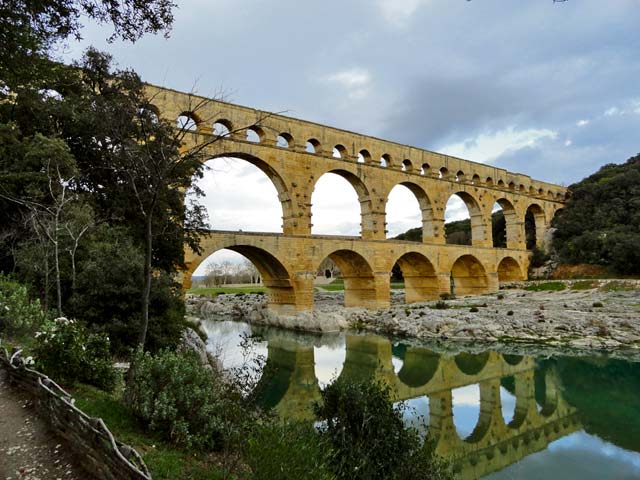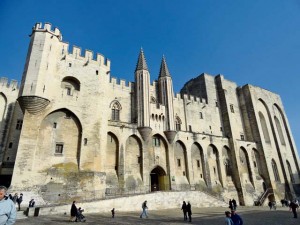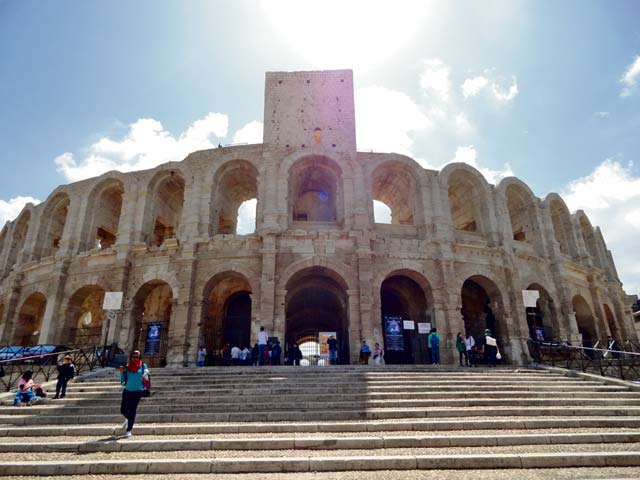by Meghan Augsburger
Ramstein High School intern

The Pont du Gard was listed as a UNESCO World Heritage site in 1985.
Visiting the provence and the French city of Avignon is like experiencing a time warp. Founded on hundreds of years of history, the entire region reflects its ancient heritage through its architecture and culture. One could say it’s a true “Roman holiday.”
City Attractions
Tracing its roots beyond the Roman Empire, Avignon developed its culture from many different influences. Its strongest architectural features resemble those of the papal era between 1309 and 1376.
One of the most popular sites in the city stems from the papal time period. Located near the center of Avignon, the Palais des Papes (Pope’s Palace) is listed as a UNESCO world heritage site with plenty of historical chambers to discover.
English audio guides are recommended for those who do not read or speak French.
Pont Saint Bénezet, a portion of a 12th century bridge, attracts many tourists as well.

Directly next to the palace is the Cathédrale d’Avignon, a magnificent church built during the 12th century. Located within the cathedral are the tomb of Pope John XXII and papal robes and relics, dating back hundreds of years.
Across the Rhône River is Villeneuve-lès-Avignon, a small town that has several interesting attractions. At the top of the town stands Fort Saint André. It offers breathtaking views of Avignon and a beautiful garden to admire.
Down below is a monastery called the Chartreuse du Val de Bénédiction that features a replica of a monk’s living quarters, frescoes and a unique church that has one missing wall.
A special exhibit has been placed inside the church to provide images of how it would have looked hundreds of years ago with its wall.
Avignon has plenty of museums to visit, too. Many provide art exhibits while others focus on regional specialties such as lavender, wine, soap and perfume.
Sightseeing Outside of Avignon
Roman ruins are scattered around Southern France and are perfect for quick excursions. Cities such as Orange, Nimes and Arles integrated Roman architecture into modern day society.
Orange houses one of the three intact theater walls of the Roman Empire. The remaining two are located in Syria and Turkey.
Within the theater wall, two columns and a statue of the emperor still stand, adding to the historical atmosphere. While in the city, don’t miss the Roman triumphal arch, covered in intricate carvings and designs.
Arles, the town made famous by Van Gogh’s paintings, also features a variety of Roman monuments. Near Arles’ city center is the arena, which still hosts bullfighting events, and the amphitheater ruins.
For art enthusiasts, the city of Arles offers walking routes that pass famous sites that Van Gogh painted.
On the outskirts of the town, there is a Roman graveyard called Les Alyscamps. In Arles, the Romans did not bury their dead. Instead, they were placed in stone coffins and left above ground.

When the city was pillaged, the sarcophagi were destroyed or used as feed troughs. Now, portions of these coffins lie broken along the pathway to the church, which was built in the 12th century.
Nimes features an amphitheater that has been well preserved, representing a smaller version of the Colosseum in Rome. The Maison Carree, an ancient Roman temple, also lasted through the ages and can still be admired in its original form.
The most astonishing sight located only 30 minutes from Avignon is the Pont du Gard, an ancient Roman aqueduct. The three-tiered masterpiece of hydraulic engineering is an ideal location for taking beautiful photos.
Parking at the Pont du Gard costs €18, which covers the admission price for the museum. Inside the museum, interactive exhibits on the purpose of the aqueduct and how it affected Roman life are available and perfect for families.
If planning on visiting more than once, it is worth it to buy a yearlong pass for €23, which covers the cost of parking.
The Camargue, a popular national park region, is covered in natural wetlands, fostering many different types of animals such as wild horses and bulls. It takes around one hour and 20 minutes to drive to the park.
Along the road to Sainte Marie de la Mer, a small vacation town by the Mediterranean Sea, there are plenty of horse riding ranches and places to stop and admire nature.
Another beautiful attraction is the Camargue Ornithological Park, a sanctuary for native birds such as flamingos and herons.
For those wishing to see more birds, horses or bulls in their natural habitats, there is a boat tour that travels straight through the wetlands.
Gastronomy
Mirroring Italian cuisine, Provencal dishes use plenty of olive oil, garlic and vegetable bases. Ratatouille, a vegetable stew, is served at most restaurants. Full of zucchini, eggplant, bell peppers and tomatoes, the stew is used as a side dish, filling or full meal.
Common sauces added to dishes include aioli, a type of garlic mayonnaise, and anchovy paste.
At many restaurants, Provencal as well as traditional dishes are listed. Escargot (snails with parsley and garlic), Crouqe Monsier (grilled ham and cheese sandwich), a variety of baguettes, and different wine-based stews are commonly found on menus.
Due to its close proximity to the sea, cuisine often features different kinds of fish. Bouillabaisse, a popular Provencal soup, is made with various types of fish, onions, tomatoes, saffron and Herbes de Provence.
Herbes de Provence, a commonly used herb mixture, contains dried basil, marjoram, thyme, savory, rosemary and sage.
Though traditionally classified as Spanish cuisine, Paella is also commonly served in cafes and restaurants in southern France.
Delicacies of the Camargue region include Fleur de Sel (sea salt), wild rice and dishes containing bull meat.


